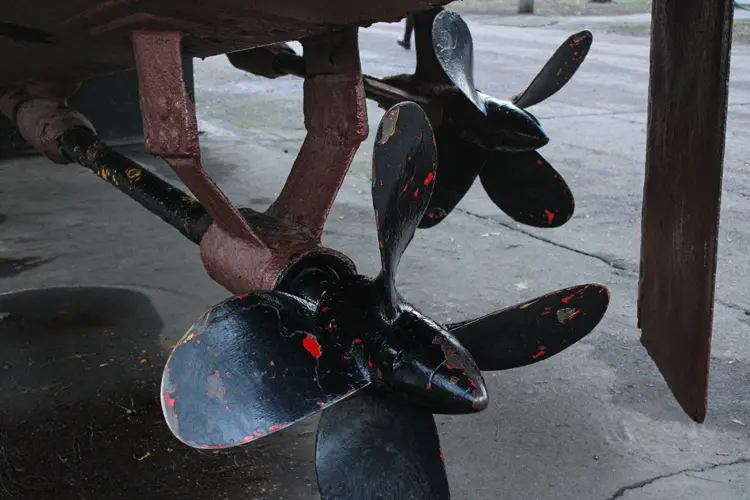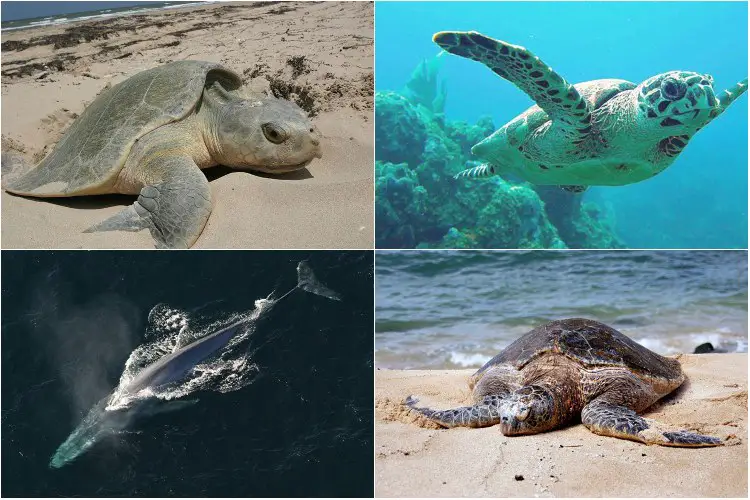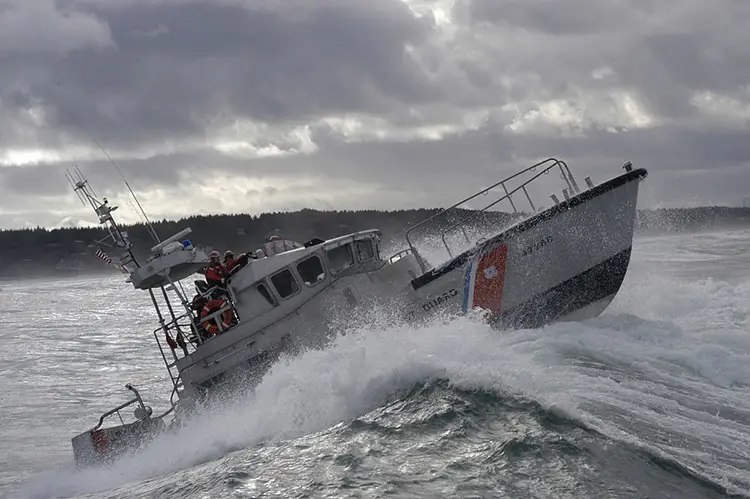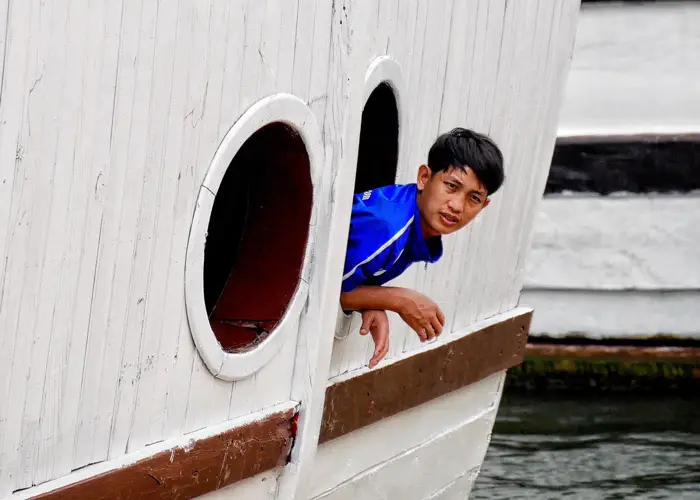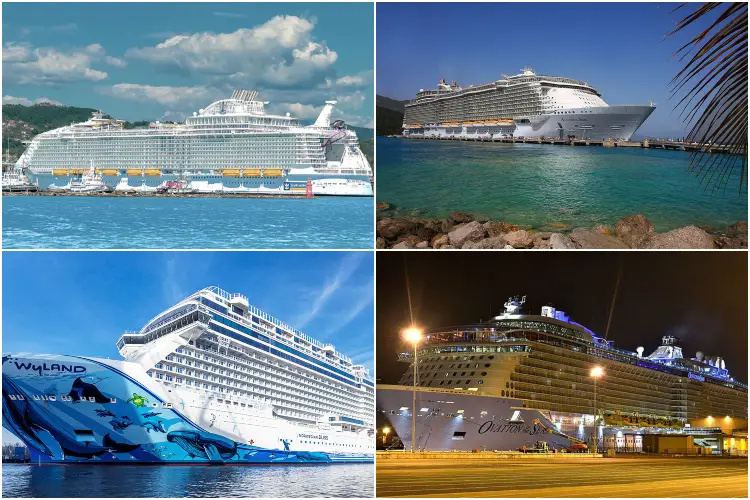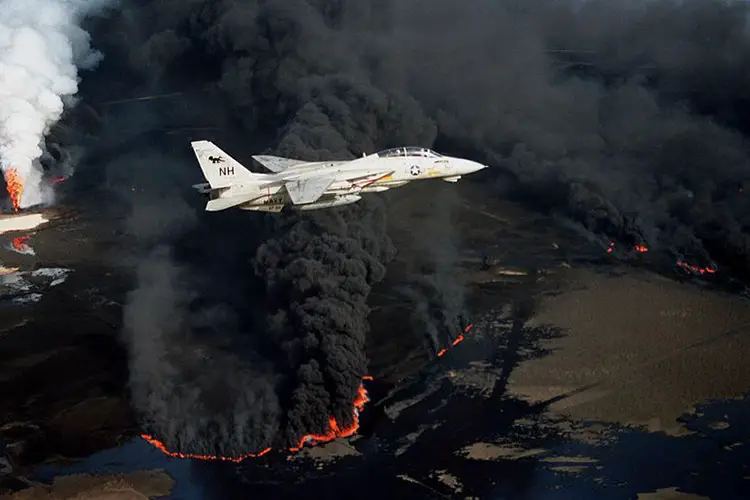16 Biggest Ports in India
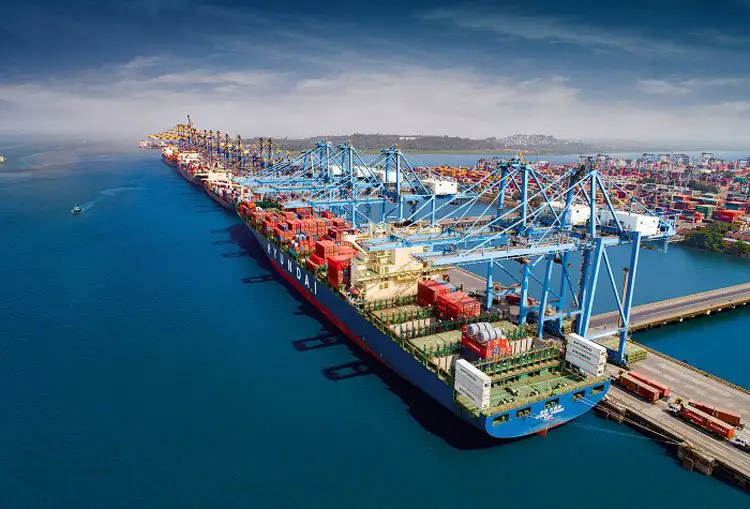
Before diving into the list of the major ports in India, let’s find out more about India’s sea trade activities and statistics.
Introduction
Kerala, Karnataka, Maharashtra, Goa, Gujarat, West Bengal, Odisha, Andhra Pradesh, and Tamil Nadu are the nine coastal states that makeup India. One of the biggest areas of land that juts out into a body of water is India’s extensive coastline. The country’s thirteen major ports handle a large volume of container and cargo traffic.
The ports of Mumbai, Kandla, Mangalore, JNPT, Mormugao, and Cochin are located on the west coast. The ports of Chennai, Tuticorin, Visakhapatnam, Paradip, Kolkata, and Ennore are located on the east coast. Ennore, the last one, is a publicly-traded firm in which the government owns a 68 percent stake. Port Blair is located in the Andaman and Nicobar Islands. Mumbai is India’s largest natural port.
Maritime transport accounts for around 95 percent of India’s commercial volume and 70 percent of its trading value, according to the Ministry of Shipping. Mr. Narendra Modi, the Prime Minister, renamed the Ministry of Shipping to the Ministry of Ports, Shipping, and Waterways in November 2020.
India has 12 large ports and 205 minor and intermediate ports that have been notified. Six new mega ports will be built in Sagarmala as part of the National Perspective Plan for the country. The ports and shipping industry in India are critical to the country’s trade and commerce growth. With a coastline of around 7,517 kilometers, India is the world’s sixteenth-largest marine country. The Indian government is a key supporter of the port industry.
It has opened up the automated route to 100 percent FDI for port and harbor building and maintenance projects. It has also made it easier for businesses that create, maintain, and operate ports, inland waterways, and inland ports to take advantage of a 10-year tax break.
Also read: Outer Port Limit: Definition & Importance
List of Major Ports in India
| Sl. No. | Name | Location |
|---|---|---|
| 1. | Kandla Port (INKDL) | Kandla, Gujarat |
| 2. | Jawaharlal Nehru Port (INNSA ) | Maharashtra |
| 3. | Mumbai Port ( INBOM) | Maharashtra |
| 4. | Visakhapatnam Port (INVIZ) | Andhra Pradesh |
| 5. | Marmagao Port (INMRM) | Goa |
| 6. | New Mangalore Port (INNML) | Karnataka |
| 7. | Chennai Port (INMAA) | Tamil Nadu |
| 8. | Cochin Port (INCOK) | Kerala |
| 9. | Haldia Port (INHAL) | Kolkata |
| 10. | Port Blair (INIXZ) | Andaman And Nicobar Islands |
| 11. | Paradip Port (INPPT) | Orissa |
| 12. | V. O. Chidambaranar Port (INTUT) | Tamil Nadu |
| 13. | Kamarajar Port (INENR) | Tamil Nadu |
| 14. | Port of Mundra (INMUN) | Gujarat |
| 15. | Port of Kolkata – Syama Prasad Mookerjee Port Trust (INCCU) | West Bengal |
| 16. | Port of Hazira (INHZR) | Gujarat |
In India, there are 13 major seaports, 12 of which are run by the Indian government and one by a private company (Ennore Port). These seaports are critical to India’s developing economy’s long-term sustainability and improvement. The majority of India’s trade passes through these ports. They also function as tourist attractions in addition to being trade centres.
1. Kandla Port, Gujarat
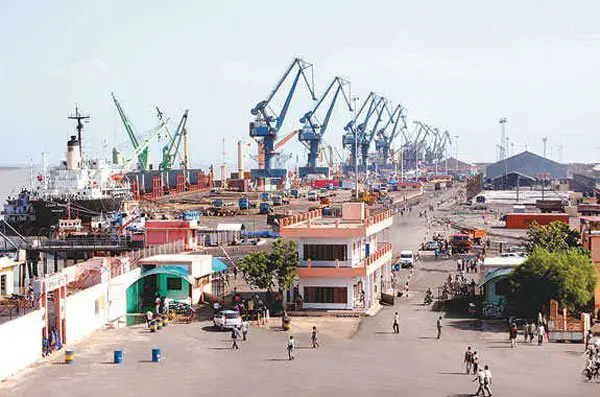
Deendayal Port Trust is a seaport and town in Gujarat’s Kutch district, near Gandhidham, in Western India. It is a prominent port on the west coast, situated on the Gulf of Kutch. Due to the partition of India, which left the port of Karachi in Pakistan, Kandla Port was built in the 1950s as the primary seaport for Western India.
The Port of Kandla is located on the Gulf of Kutch on India’s northwestern coast, approximately 256 nautical miles southeast of Pakistan’s Port of Karachi and around 430 nautical miles north-northwest of Mumbai. By volume of cargo handled, Kandla is India’s busiest port. With private sector engagement, Kandla Port Trust, India’s busiest major port in recent years, is planning to expand cargo handling capacity significantly. In 2008-09, the west coast port handled 7,223 crore (72,225 million) tonnes of cargo, up from 6,492 crore (64,920 million) tonnes in the previous year.
While handling crude oil imports, primarily for Essar Oil’s Vadinar refinery in Gujarat, has contributed to the port’s expansion, it is also taking steps to increase non-POL cargo. POL traffic accounted for 63% of all cargo handled at Kandla Port last fiscal year, up from 59 percent in 2007-08.
The port will shortly begin the process of selecting developers for four clean cargo berths with a combined capacity of 8 million tonnes. A 14 m draught will support the four berths, which will be capable of holding 75,000 dwt boats. The port has already got positive feedback from potential bidders for the project, which is expected to cost close to 500 crore.
The port handled 10.6 crore (106 million) tonnes of cargo in 2015-16. Under the India Port Act of 1908, Kandla Port was renamed Deendayal Port Trust.
Also Read: Major ports in Spain
2. Jawaharlal Nehru Port, Maharashtra (Earlier Known as Nhava Sheva)

The largest container port in India is Jawaharlal Nehru Port, popularly known as Nhava Sheva Port. JNPT is located east of Mumbai, in Maharashtra, and handles the majority of India’s containerized traffic as well as long-haul calls to and from emerging markets. When it served MSC Perle, DP World’s “futuristic” Nhava Sheva (India) Gateway Terminal (NSIGT) achieved 6,017 TEUs of combined exports and imports in around 33 hours, with gross berth productivity of 141.14 moves per hour.
The inclusion of a weekly intra-Asian call from HMM has greatly improved the growth prospects for PSA International’s new terminal at India’s busiest container gateway, Jawaharlal Nehru Port Trust (JNPT). HMM’s six-vessel China-India Express (CIX) Service made its BMCT debut on Jan. 2 with a call from the 8,562-TEU Hyundai Loyalty, underlining JNPT’s intra-Asian trade potential.
The Nhava Sheva International Container Terminal (NSICT) is leased to a group led by P & O, which is now owned by DP World. It was launched in July 2000 and includes a 600-meter (2,000-foot) dock with two berths. It has a freight capacity of 62.15 million tonnes. The NSICT Container Terminal was India’s first privately run container terminal. GTI (Gateway Terminals India Pvt Ltd), a third container port operated by APM Terminals with a capacity of 1.3 million TEUs, was opened in 2006.
By July 2016, NSIGT, a new freestanding container terminal with a quay length of 330 metres and a capacity of 12.5 million tonnes, will be completely operating. PSA International will build and operate the fourth container terminal, Bharat Mumbai Container Terminals (BMCT). Phase 1 of the project, with a capacity of 2.4 million TEUs per year, was completed in December 2017.
By the end of Phase 2, the terminal will have a full capacity of 4.8 million TEUs per year and a quay length of 2,000 metres.
The port began marking cargo with logistics data in 2006. Container Freight Stations and Logistics Parks owned by the government and private players, such as Maharashtra State Warehousing Corporation, DRT, Gateway District Park, Allcargo, Avashya, Continental Warehousing, Ameya Logistics, TransIndia, and Contegrate Entrepot, provide India’s best logistics connectivity. The JNPT has been attempting to establish a direct port delivery model for containers, a first-of-its-kind approach touted as part of India’s ease of doing business initiative.
3. Mumbai Port, Maharashtra
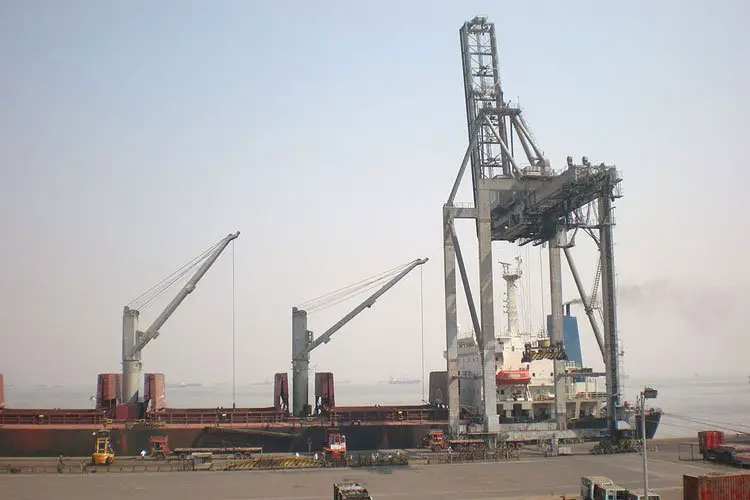
The Port of Mumbai is one of India’s most important ports, and it is located in Mumbai, Maharashtra’s capital city. The port features a 400-square-kilometre natural deepwater harbour that is protected on the east by the Konkan peninsula and on the west by the Mumbai island.
The port, which opened in 1873, has already served for 137 years. The Mumbai Port Trust is in charge of it. The port is 46.3 hectares in size, with 63 mooring spots and a total quay length of 7,800 metres. Pilotage is required for ships weighing more than 100 tonnes that enter or leave the harbour, according to the port.
The port was closed for a few days in August 2010 due to an oil spill caused by the collision of merchant boats MSC Chitra and MV Khalija-III five nautical miles off the coast of Mumbai. As the ship slanted after the collision, crude oil containers of the MSC Chitra spilled into the ocean and leaked. Hundreds of thousands of gallons of oil are thought to have spilled into the Arabian Sea.
The Mumbai Port offers comprehensive seaport services for cargo handling, storage, and delivery.
A 126-kilometre road network connects the port to the rest of the city. The port has its own railway system, which is connected to the Central and Western Railway via the main line’s broad gauge. The port’s railway system serves docks, vital installations, and factories on its estates, with a track length of over 100 kilometres and five diesel locomotives.
For generations, ships and boats have used Mumbai Harbour. The Maratha Navy, as well as the British and Portuguese colonial navies, all employed it. The East India Company’s Surat Council, seeing the Port’s geographic advantage, pushed for its purchase from the Portuguese in 1652.
The ‘Port and Island of Bombay’ were passed to the king of Great Britain via the Marriage Treaty between Charles II of Great Britain and the Infant Catherine of Portugal nine years later. The first of the Port’s modern docks was constructed in the 1870s. On June 26, 1873, the Bombay Port Trust (BPT) was created as a corporation. Colonel J.A. Ballard was the organization’s first chairman.
4. Visakhapatnam Port, Andhra Pradesh
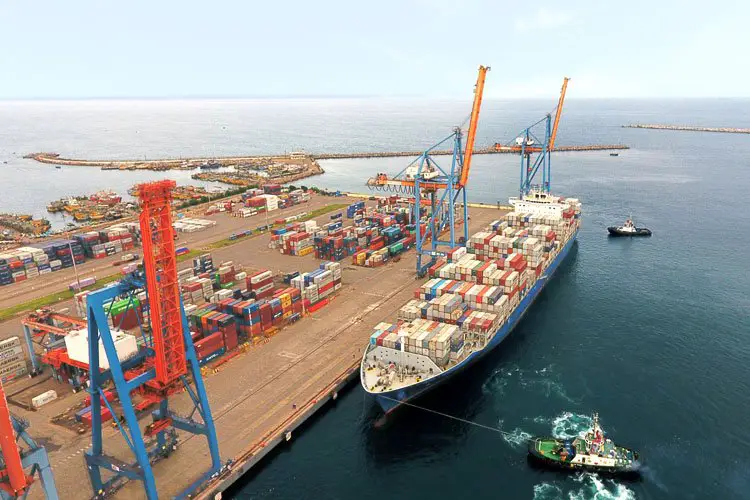
Visakhapatnam was a historic port city with ties to the Middle East and Rome. Small Masula boats ferried freight from Visakhapatnam shore to ships anchored on open roads. The inscriptions of Sri Bheemeswara Swamy temple (1068 AD) in East Godavari District, Andhra Pradesh, contain a reference to a Vizagapatam merchant. Vizagapatam was a fortified mercantile town under the control of a guild in the 12th century AD. In 1682, a branch of the East India Company established a settlement there. In 1882-83, Vizagapatam / Bhimunipatnam handled 83 lakh rupees worth of products.
Muslin cloth manufactured at Uppada (East Godavari District), Manganese ore exports to the United Kingdom and the United States, Oilseeds, jaggery, jute and indigo, hides and skins were among the main goods traded at the anchoring Port. Burma had extensive trading links with the United States. The Port was frequently frequented by vessels of the British India Steam Navigation Company.
The need for a port in this section of the country was stressed in a British Survey Party report following the establishment of British rule in 1858. In 1877, a paper titled Vizag the Port of Central Provinces underlined the importance of building a port in Visakhapatnam. The proposal of Col.H.Cartwright Reid of the British Admiralty for the construction of a harbour at Visakhapatnam at the mouth of the river Meghadrigedda was only approved by the Government after the First World War (1914-18).
The Island Break-water, a distinctive feature of the harbour, was built by scuttling two old ships, JANUS and WELLESDON, which form the skeleton around which a debris pile is formed. Mr.W.C.Ash and Mr. D.B.Rattenberry, two engineers, were important in bringing this engineering marvel to life.
The arrival of a passenger vessel from the Scindia Steam Navigation Co., the S.S.JALADURGA, on the 7th of October, 1933, signalled the start of ocean traffic at the Port. His Excellency Lord Willingdon, the then Viceroy and Governor-General of India, formally opened the port on December 19, 1933. The Port handled 1.3 lakh tonnes of traffic during its first year of operation. 1.2 lakh tonnes were exported, while 0.1 lakh tonnes were imported. Manganese ore and groundnuts were the main items exported. Rice, flour, tiles, and other consumable items were among the items imported. Bullock carts were used to transport the freight.
During World War II (1939-42) the Port grew in importance as a military base. Following the war and the country’s independence, the planned expansion of the Port began with the country’s Five Year Plans. In order to develop the Port’s infrastructure, significant expenditures were undertaken in the subsequent Five Year Plans. The transformation of a tiny port with three berths and yearly traffic of 1.3 lakh tonnes into a leading Major Port with 24 berths and annual throughput of 65 million tonnes entailed many milestones.
Also Read: Major ports in China
5. Marmagao Port, Goa
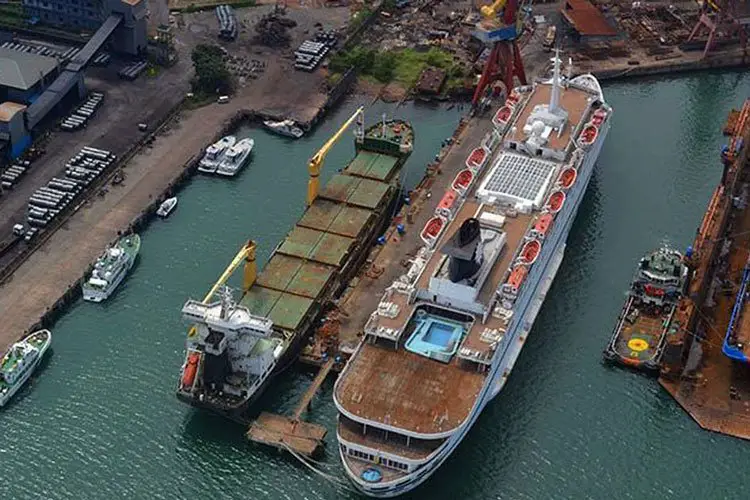
It’s no surprise that Goa is known for its beaches, but did you know it’s also home to one of India’s largest seaports? The Marmagao Port, located in south Goa, is one of India’s most tranquil and laid-back ports. This port is one of India’s most famous tourist destinations, with many people flocking to see the operation firsthand. This is one of India’s earliest modern ports, and it’s for good cause. Because of how accessible it has become now, the launch of the Konkan railway has boosted the popularity of this port even more.
Mormugao Port, which was established in 1885 and is located in the state of Goa, is one of the oldest ports on the west coast of India, with a protected open style natural harbour. It has grown a deep draught channel over time. It is an important part of Goa’s thriving export economy because of its location at the mouth of the Zuari River. In 1964, it became one of the country’s major ports, and it has been dedicated to the country’s economic development ever since.
Mormugao Port Trust (MPT) is a port in Goa, India’s westernmost state. It is India’s oldest port, having been built in 1885 on the location of a natural harbour. Around 2,600 people work at the port, while 4,000 people are retired. The Mormugao Port Trust, which operates the port, is the Vasco region’s main employer, with a whole mini-township in Headland Sada that includes schools, residential complexes, and services (such as a hospital) for the Port’s employees.
With around 54.50 million metric tonnes (MMT) of iron ore traffic in 2010–11, MPT briefly became India’s biggest iron ore exporting port (about 90% of this was exported to China). Due to a global decline in iron ore demand, the port’s cargo tonnage declined to 39 MMT in 2011-12, with iron ore accounting for 29.21 MMT.
The MPT’s berths 10 and 11 are designated for coal handling. Manganese and bauxite are also exported by MPT. Berths 1, 2, and 3 were decommissioned in 1992 and handed over to Western India Shipyard Ltd. for the construction of a modern ship repair facility with a floating dry dock. Berth no. 7 is a berth with a shallow draught that is intended for the shipping of coastal freight (now given to Adani).
Ships carrying naphtha, ammonium, or phosphorus dock at MPT, and the cargo is transferred by tankers and pipelines to Zuari Indian Oil Tanking Ltd (ZIOL) at Zuarinagar. The 2011 naphtha fires were the result of a leak in one of these pipelines. Frozen fish, liquor, iron casting, pig iron, and pharmaceutical items were among MPT’s main exports in 2014, while heavy melting scrap, shredded scrap, potassium carbonate, and steel turning were among its significant imports.
6. New Mangalore Port, Karnataka
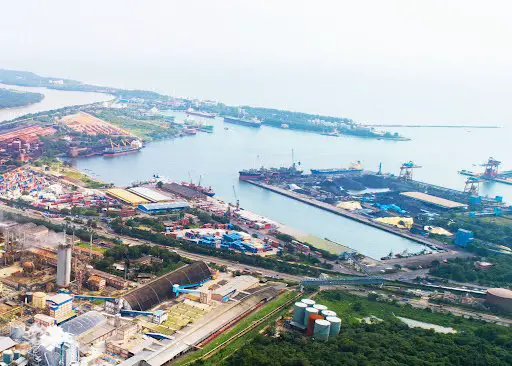
Mangalore has a lengthy and illustrious history that dates back to the time of the early Christians. The Great Library of Alexandria, Egypt, contains texts about Mangalore. As the original port was located at the confluence of the Gurpur and Netravati rivers, Roman history depicts Mangalore as a port on the mouth of the river Netras (Netravati). Mangalore, dubbed Mangala in Greek play, is also mentioned.
In his travelogue, Ptolemy, the astronomer and great traveller of the 2nd century, mentions Mangalore. Arab traders maintained booming commerce in silk and spices between Mangalore and West Asia under the Vijayanagara Empire, and it is now regarded as the Gateway of Karnataka. The Old Port (Bunder), located at the confluence of the Gurupur and Nethravathi rivers, has its own set of challenges in meeting the expanding demand for marine trade. The need for a new port became apparent, and the New Mangalore Port was established.
The name “New Mangalore Port” separates it from the “Mangalore Bunder” or “Old Bunder,” an old harbour or port in Mangalore city. The ancient harbour, located south of New Mangalore Port, is now utilised for fishing and small cargo ferries. The port serves the hinterlands of Karnataka and, to a lesser extent, Kerala. Iron ore concentrates and pellets, iron ore fines, manganese, granite stones, coffee, cashew, and containerized goods are among the main exports from the port.
Crude and petroleum products, LPG, wood pulp, lumber logs, finished fertilisers, liquid ammonia, sand, phosphoric acid, other liquid chemicals, and containerized goods are the port’s main imports. Cruise ships can dock at the new Mangaluru Port. International tourists arrive here to visit Karnataka’s coastline region (Karavali). It has a helicopter service for passengers arriving by cruise liner.
In 1962, the Mangalore Harbour Project was established. The project’s maritime construction began in 1968. The New Mangalore Port, Karnataka’s only major port, was designated as the country’s ninth major port on May 4, 1974, and publicly opened on January 11, 1975, by then-Indian Prime Minister Smt. Indira Gandhi. With effect from 1.4.1980, the terms of the Major Port Trust Act 1963 were applied to NMPT. Since then, the Port has served as a hub of activity for the region’s importers and exporters.
7. Chennai Port, Tamil Nadu
Chennai Port, formerly known as Madras Port, is India’s second-largest container port, after Nhava Sheva in Mumbai. In the Bay of Bengal, the port is the largest. It is the third-oldest port in India, with official port operations beginning in 1881, however maritime trading began much earlier, in 1639, on the undeveloped shore.
It’s an all-weather, artificial harbour with wet docks. In the post-Independence era, it transitioned from a large travel port to a major container port. The port is a major contributor to the city’s development and remains a major factor for Tamil Nadu’s economic growth, particularly the manufacturing boom in South India.
The city of Chennai earned the nickname “Gateway to South India” as a result of the port’s existence. The port has grown into a major hub for containers, automobiles, and project cargo on India’s east coast. The port has grown from processing a small volume of cargo in its early years, primarily oil and motors imports and groundnuts, granite, and ores exports, to carrying more than 60 million tonnes of cargo in recent years. The port’s container traffic exceeded one million twenty-foot equivalent units in 2008. (TEUs).
In 2011, the Chennai Port was rated as the world’s 86th largest container port, with plans to increase capacity to almost 140 million tonnes per year. It is an ISO 14001:2004 and ISPS-certified port that has grown into a mainline port with direct connections to over 50 ports worldwide.
8. Cochin Port, Kerala
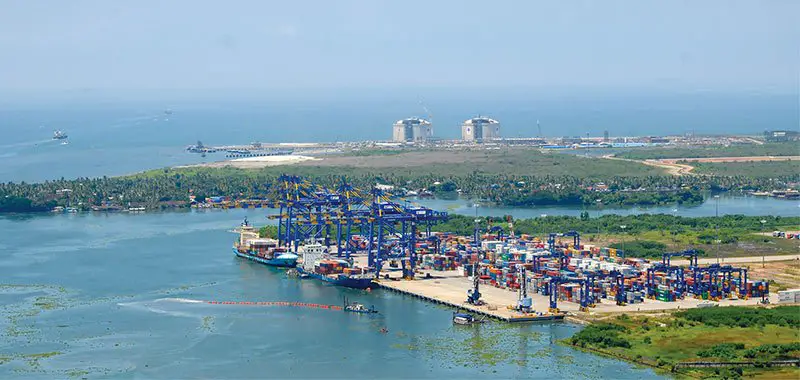
The Cochin Port, like it once did, maintains a tight relationship with a variety of businesses, including an oil refinery, cashew and spice exports, marine, and tourism. It has developed to become one of India’s most important ports, with over 1100 vessels passing through each year. It also transports 13.5 million tonnes of freight each year. Despite the fact that the port facilities are now on Willington Island, it still has a large area at Vallarpadam and Puthuvypeen. With the construction of the International Container Terminal on Vallarpadam Island, the Port will soon become a major transhipment hub.
Apart from this transhipment port, which will be India’s first of its kind, other big projects are in the works, such as the construction of an LNG regasification plant near Puthuvypeen. The Port also has cruise terminal and bunkering terminal services.
Cochin Port has also been designated as a stopover for yachts competing in the Volvo Ocean Race. Regardless of the season or weather, cruise liners continue to arrive at the port. Naval ships from all over the world dock here in order to connect professionally with the Indian Navy.
Cochin Port expects increased commercial partnerships with countries all over the world now that the e-port service has been launched and transactions have gone online. In short, Cochin Port is a hive of activity throughout the year, and it has played a significant role in the city’s development as a major industrial and commercial centre.
Increasing trade operations between Kochi and the nations across the sea occurred in the 19th and 20th centuries. Ships arriving in Kochi used to berth on the open seas in the early 1920s. The lighters – tiny vessels – were in charge of cargo loading and unloading. They were continually exposed to the ferocity of Nature because they were tethered in the open sea. As a result of these issues, the trading community began to urge that the port be expanded.
Between the peninsular headland Vypeen and Fort Kochi, the Cochin Gut provides access to the Port of Cochin. The port’s boundaries encompass the whole backwaters, as well as the creeks and channels that connect them. The Cochin Gut approach canal is approximately 1000 metres long, with an intended width of 200 metres and a dredged depth of 13.8 metres (now dredging for 16 metres for ICTT).
The channel splits at the stomach into the Mattancherry and Ernakulam channels, which lead west and east of Willingdon Island, respectively. Wharves, berths, jetties, and stream moorings have been built beside these channels to provide berthing facilities for ships.
9. Haldia Port, Kolkata
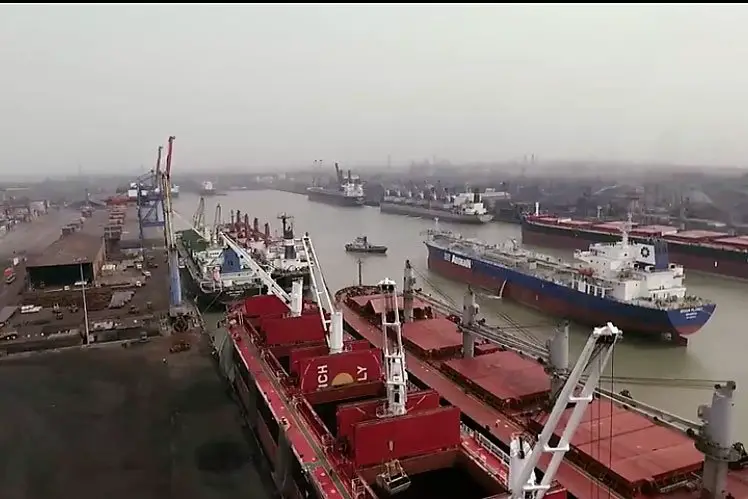
The Haldia port, also known as the Haldia Dock Complex, is located at the confluence of the Haldi River and the Hooghly River. As the port’s partner, the Kolkata Port Trust was established. As a result, it isn’t a port. It’s a government-run dock complex.
It has a huge hinterland that includes West Bengal, Bihar, Jharkhand, Uttar Pradesh, Madhya Pradesh, Assam, the North East Hill States, and two landlocked neighbouring nations, Nepal and Bhutan, as well as the Tibetan Autonomous Region (China). Throughput has been gradually increasing since the turn of the century.
One of the three Customs Commissionerates in the Kolkata Customs Zone is the Kolkata Customs Port Commissionerate. Commissioner of Customs, Kolkata (Port) has jurisdiction over the ports of Kolkata, Haldia, the Andaman and Nicobar Islands, the area under the jurisdiction of Kolkata, Howrah, and South Suburban Corporations, as well as all lands within 10 kilometres of the Hoogly river’s high watermark at spring tide on either side of the river.
Customs is mandated to collect intelligence and conduct investigations connected to specific economic offences and smuggling, in addition to serving as a revenue collection agency under the Ministry of Finance and as a regulatory wing on behalf of several Government Departments. The Kolkata Customs (Port) formation generates about 90% of the revenue received in the Kolkata Customs Zone in terms of revenue collection.
Initially, KoPT research focused on river training and bank protection projects in the Hugli River’s upstream portions, as well as in the Kolkata area. Following that, studies for the development of port facilities and a navigation channel from Saugor to Kolkata, as well as a few estuarine training works, were conducted.
10. Port Blair, Andaman And Nicobar Islands
Port Blair Port is a seaport in India’s Andaman and Nicobar Islands’ South Andaman region, close to the city of Port Blair. It is one of India’s largest ports, located on the Andaman Sea. The Port Blair Port Trust manages the port. From June 1, 2010, all principal provisions of the Major Port Trusts Act, 1963, apply to the major port of Port Blair. With this, Port Blair becomes India’s 13th largest port and the sole major port in the Andaman and Nicobar Islands.
East Island Port, Mayabunder Port, Elphinston Harbour Rangat Port, Havelock Port, Neil Island Port, Chowra Port, Teressa Port, and Nancowry Harbour Port will all fall under the territorial jurisdiction of the Port Blair port.
Port Blair is an upcoming city similar to any other minor Indian city, despite the fact that the seaside has been tarted up a bit, given the beauty of the rest of the Andamans. It is made up of individuals from all around India, and it can be thought of as a miniature India with no regional or religious problems.
Apart from Cellular Jail, there are just a few places worth seeing, such as Ross Island, Barren Island (home to the world’s only active volcano), and a few others with historical significance. A week’s journey will take you to all of the island’s must-see attractions. You can, however, take a day trip to nearby attractions such as Wandoor and Ross Island.
Also Read: Major ports in UAE
11. Paradip Port, Orissa
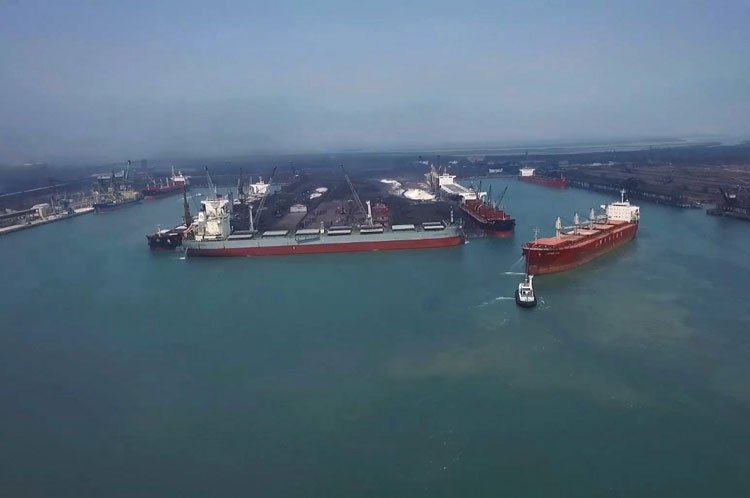
Paradip Port is a natural, deep-water port on India’s east coast, located in the Odisha district of Jagatsinghpur. It’s located at the junction of the Mahanadi and the Bay of Bengal rivers. It’s about 210 miles south of Kolkata and 260 miles north of Visakhapatnam. The Paradip Port Trust (PPT), an autonomous company completely owned by the Indian government, manages the port.
The Paradip port is one of India’s deepwater seaports, located along the coast of Orissa. The port’s depth enables it to handle both large and bulk containers. This port mostly handles iron ore and coal. Iron ore is exported in large quantities to Japan.
The number of exports from this port is always greater than the number of imports. Imports to the Paradip port totaled 6,991 thousand tonnes in 2003, while exports totaled 16,910 thousand tonnes. This port even has its own train system, which makes transportation convenient. The Paradip port has recently received an oil jetty that can handle up to 8 million tonnes of petroleum products and tankers with a displacement of 85,000 DWT, making it even more efficient and better.
On the 3rd of January 1962, late Prime Minister Jawaharlal Nehru lay the foundation stone of the Port near the confluence of the Mahanadi and the Bay of Bengal. On June 1, 1965, the Government of India took over operation of the Port from the Government of Odisha. On March 12th, 1966, the INS “Investigator” earned the honour of becoming the first ship to dock in the Port.
On the same day, Late Peter Stambolic, Yugoslavia’s then-Prime Minister, proclaimed the port open. On April 18, 1966, the Indian government designated Paradip Port as the country’s eighth major port, making it the first major port on the East Coast to open after independence.
The Port of Paradip is run by a Board of Trustees appointed by the Government of India, which is headed by the Chairman. The Port of Paradip is an autonomous organisation established under the Major Port Trusts Act, 1963, and functions under the Ministry of Ports, Shipping & Waterways.
The Trustees of the Trust Board are chosen by the Government of India from among the port’s numerous users, including shippers, ship owners, government departments, and port labour. The Chairman, with the assistance of the Deputy Chairman and other departmental heads, oversees and controls the day-to-day administration.
12. V. O. Chidambaranar Port (Tuticorin Port), Tamil Nadu
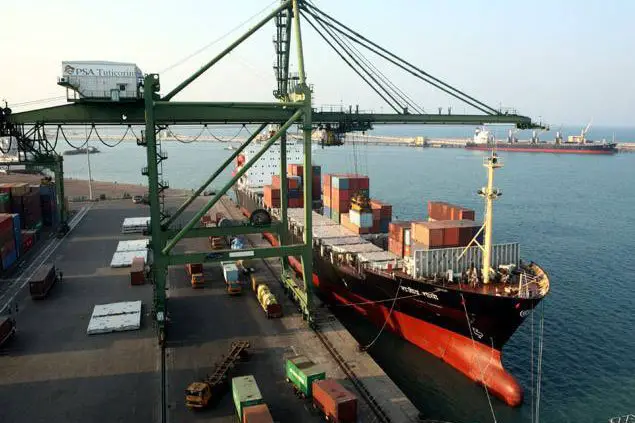
V. O. Chidambaranar Port, earlier known as the Tuticorin Port, one of India’s 13 main ports, is a modern port that was recently built in Tamil Nadu. It is a man-made harbour located 8 kilometres south of the original Tuticorin port. The port mostly deals with Sri Lanka and is well-connected by rail and road. It is also Tamil Nadu’s second-largest port.
It is known as the Pearl City and is the best place in the Bay of Bengal for pearl fishing. Coal, salt, food grains, edible oil, sugar, and petroleum products are the most common commodities traded. Its depth will be expanded to 12.8 metres from the existing 10.7 metres, and an outer harbour will be built in the near future.
For more than 2000 years, Thoothukudi has been a centre for marine trade and pearl fishing. The Port’s development was sparked by the natural harbour’s rich hinterland, which began with wooden piers and iron screw pile piers, as well as railway connections. In 1868, Thoothukudi was designated as a small anchorage port. Over the years, there have been numerous developments.
State governments are generally responsible for the development of minor ports.
The Indian government is also aware that a traffic survey has recently begun. The Government of Madras has been considering the construction of Tuticorin as a deep sea port since 1920. The numerous plans for the development of Tuticorin Harbour that have been submitted to the government.
13. Kamarajar Port (Ennore Port), Chennai
Kamarajar Port Limited, originally Ennore Port, is a public enterprise located on the Coromandel Coast about 18 kilometres north of Chennai Port. It is India’s 12th largest port and the country’s first. The only significant port that has been corporatized and is registered as a business is Kamarajar Port Limited. On March 27, 2020, the Chennai Port Trust bought a 67 percent ownership in Kamarajar Port Limited from the Centre. The Chennai Port Trust held the remaining 23% of the shares. Private entrepreneurs have invested $26,000 million in various terminals and harbour boats at the port.
The first corporatised port in India, Kamarajar Port Limited, is designed as Asia’s energy port and employs only 86 people. Kamarajar Port Limited is maturing into a full-fledged port with the potential to handle a wide range of products. It was originally envisioned as a satellite port to relieve congestion and improve environmental quality at the busy Chennai Port. The port handled a total volume of 11.01 million tonnes in 2010–11, up 2.86 percent from the previous year, with an allowable draught of 13.5 m.
On a flat coastal plain known as the Eastern Coastal Plains, Ennore Port is located in the northeastern corner of Chennai City, Tamil Nadu State. It is situated 2.6 kilometres north of the Ennore Creek on the east coast of the Indian peninsula, known as the Coromandel Coast, in the Bay of Bengal. Athipattu Pudunagar is a nearby train station. The port receives low seasonal temperature fluctuations, ranging from a maximum of 38–42 °C in summer to a minimum of 18–20 °C in winter, thanks to its coastal location and proximity to the thermal equator zone.
For most of the year, the weather is hot and humid, and the region has a tropical wet and dry climate. From September through December, the northeast monsoon winds bring seasonal rains and, on rare occasions, cyclones to the region. The region receives roughly 1400 mm of rain per year (55 in).
The southwesterly winds prevail between April and October, while the northeasterly winds prevail the rest of the year. The port is situated in a Seismic Zone III area, which indicates a considerable danger of earthquake. The port and the town of Ennore are separated by Ennore Creek towards the south.
Also Read: Ancient Ports in India
14) Port of Mundra
Mundra Port is India’s largest private port, located near Mundra in the Kutch state of Gujarat on the north shores of the Gulf of Kutch. Previously controlled by Adani Group’s Mundra Port and Special Economic Zone Limited, it was later extended into Adani Ports & SEZ Limited, which now manages many ports.
The Gujarat Maritime Board (GMB) sanctioned the construction of a captive jetty at Mundra Port in 1994. The Gujarat Adani Port Ltd., a joint-sector business, was formed in 1998, and multi-purpose berths 1 and 2 at Terminal I were opened. On October 7, 1998, the MT Alpha-2, a tiny tanker, was the first ship to anchor. Terminal I’s multi-purpose berths 3 and 4 opened in 1999.
GMB secured a concession arrangement with the Port of Mundra in 2001 for the development, operation, and maintenance of the Mundra port. The private Mundra-Adipur railway line was also constructed in 2001, and it was connected with Indian Railways in 2002.
Mundra Port’s marine infrastructure includes ten berths for dry bulk and breakbulk cargo, three berths for liquid cargo, six container berths, one of which is a Ro-Ro berth, three berths for mechanised import cargo, and two single point moorings for crude oil imports. Other berths can take vessels with a maximum draught of 17 metres, while the mechanised import cargo berths can accommodate vessels with a maximum draught of 19 metres. A 32-metre draught is available at the SPM facility.
The port has its own tug and pilot fleet. Mundra Port also has a fleet of dredgers for capital and maintenance dredging, guaranteeing that the port has the deepest draught of all Indian ports. Mundra Port Coal Facility is the largest coal import terminal in the world. It has an annual capacity of 4 crores (40 million) tonnes of coal. It cost 2,000 crores ($280 million) to construct.
15) Port of Kolkata – Syama Prasad Mookerjee Port Trust
The Port of Kolkata or Kolkata Port (KoPT), officially known as Syama Prasad Mookerjee Port Trust, is India’s only riverine major port, located 203 kilometres (126 miles) from the sea in Kolkata, West Bengal. It was built by the British East India Company and is India’s oldest working port. Kolkata is a saltwater port with no salinity variations. The port includes two separate dock systems: the Kolkata Docks in Kolkata and the Haldia Dock Complex near Haldia, which has a deep water dock.
Kolkata Port was British India’s most important port in the nineteenth century. Following the abolition of slavery in 1833, there was a significant demand for sugar cane plantation labourers throughout the British Empire. Between 1838 and 1917, the British used this port to ship over half a million Indians from all over India — mostly from the Hindi Belt (especially Bhojpur and Awadh) — to places around the world as indentured labourers, including Mauritius, Fiji, South Africa, Trinidad and Tobago, Guyana, Suriname, and other Caribbean islands.
In today’s world, there are millions of Indo-Mauritians, Indo-Fijians, and Indo-Caribbeans. Because of reasons such as the Partition of Bengal (1947), a drop in the size of the port hinterland, and economic stagnation in eastern India, the port’s prominence declined after independence.
Kolkata merchants advocated the establishment of a port trust in 1863 as the city increased in size and prominence. In 1866, the colonial government established a River Trust, but it quickly collapsed, and the government once again took over governance. The Calcutta Port Act (Act V of 1870) was finally approved in 1870, establishing the offices of Calcutta Port Commissioners. Eight jetties were installed on the Strand between 1869 and 1870. In 1892, a wet dock was built in Khidirpur.
In 1902, the Khidirpur Dock II was built. As the port’s cargo traffic increased, so did the demand for more kerosene, prompting the construction of a petroleum wharf at Budge Budge in 1896. The Garden Reach jetty was built in 1925 to accommodate increased cargo traffic. In 1928, a new dock named King George’s Dock was opened (it was renamed Netaji Subhash Dock in 1973).
Despite the fact that the port was designed to be a commercial port and eastern India’s gateway, it played a critical role in WWII. The Japanese army bombed it twice. The Commissioners for the Port of Kolkata were in charge of the port after independence until January 1975, when the Major Port Trusts Act, 1963, took effect. The Port is now governed by a Board of Trustees, which includes representatives from the government, trade associations, port users, labour unions, and other nominated members. Prime Minister Narendra Modi renamed the port Syama Prasad Mookerjee Port on the occasion of the 150th anniversary of Kolkata Port’s operation at Netaji Indoor St. on January 12, 2020.
16) Port of Hazira
The port of Hazira (Hazira LNG Terminal and Port) was developed by Hazira Port Private Ltd (HPPL) under the development rights granted by Gujarat Maritime Board (GMB); the port is being developed under the BOOT policy (Build Own Operate Transfer) and will be transferred back to GMB after the 30-year BOOT period is completed. HPPL was founded by Shell Gas BV and Total Gaz Electricite Holdings France as a joint venture. Shell Gas BV has since purchased a 100 percent stake in the company.
Hazira Port or Surat Port is a deep-water liquefied natural gas (LNG) terminal and multi-cargo deep-water port established by Hazira Port Private Limited around 20 miles southwest of Surat, India (HPPL). The LNG facility is up and running, but the cargo port is still in the works. Shell Gas B.V. (Shell) and Total Gaz Electricité Holdings France have formed a joint venture (Total). Shell owns 74 percent of the company, while Total owns the rest.
Bulk, break-bulk, bulk liquid chemicals, petroleum products & edible oil, containers, automobiles, and crude are all handled by Adani Hazira Port Ltd. (AHPL). AHPL offers good multimodal access to the northern, north-western, and central areas of India, in addition to its vicinity to the Delhi-Mumbai Industrial Corridor, one of the world’s largest high-tech industrial zones. It also serves as an important international commerce hub for Europe, Africa, North America, and the Middle East.
The terminal now has 5 berths with a total quay length of 1,450 metres and operational draughts varying from 12 to 14 metres. The primary navigation channel is 7 kilometres long and is marked with beacons and buoys. It has a depth of 12 metres below CD, a width of 300 metres, and a turning radius of 600 metres.
Market Size of Major Ports in India
The capacity of India’s major ports was 1,534.91 million tonnes per annum (MTPA) in FY20. All of India’s major ports handled 672.60 million tonnes (MT) of cargo in FY21. In FY21, merchandise exports totaled US$ 255.92 billion (until February 2021). Through mechanisation, deepening the draught, and quick evacuations, the government has taken many steps to increase operating efficiency.
Investments/Developments
The Competition Commission of India (CCI) authorised Adani Ports and Special Economic Zone Limited’s intention to acquire 89.6% of Gangavaram Port Limited in April 2021. Adani Ports announced an agreement with Vishwa Samudra Holdings Pvt. Ltd. in April 2021 to purchase a 25% stake in Adani Krishnapatnam Port Limited (Krishnapatnam Port) for Rs. 2,800 crore (US$ 226.4 billion).
Adani Ports and Special Economic Zone Limited announced plans to purchase 58.1 percent of Gangavaram Port Limited for Rs. 36.04 billion (US$ 493.7 million) in March 2021. DVS Raju and his family currently own the port. Adani Ports announced in March 2021 that it would partner with John Keells Holdings and the Sri Lankan Ports Authority for 35 years to develop and operate the West Container Terminal of the Colombo Port in Sri Lanka.
As part of its green port initiatives, the JNPT (Jawaharlal Nehru Port Trust) initiated a comprehensive solid waste management project in February 2021. The operator of the western Indian port of Mormugoa, Mormugoa Port Trust (MPT), extended concessions on iron ore imports and export freight traffic till June 2021 in November 2020 to help relieve India’s iron ore shipping trade in the wake of the COVID-19 outbreak.
JSW Infrastructure completed the purchase of Chettinad Group’s port business for Rs 1,000 crore (US$ 135.50 million) in November 2020. JSW Infrastructure would be able to own and operate a deep draught international coal terminal and a bulk terminal at Kamarajar Port Limited (KPL), as well as a coal and bulk commodity terminal at New Mangalore Port Trust, as a result of this transaction (NMPT).
Krishnapatnam Port Company Ltd. (KPCL) was purchased for Rs 12,000 crore (US$ 1.63 billion) by Adani Ports and Special Economic Zone Limited (APSEZ) in October 2020. Adani Ports and SEZ Ltd issued an offshore bond sale in July 2020, raising US$ 750 million.
Between April 2000 and June 2020, India’s port sector received a total of US$ 1.63 billion in FDI. DP World inaugurated a new train service between Kochi and Bangalore in January 2020, lowering expenses and cutting transit time between the two cities by more than 40%.
Government Initiatives
The following are some of the government’s significant measures to promote India’s port sector:
Due to the COVID-19 pandemic, JNPT and New Mangalore Port handled 120 tonnes of medical oxygen on a priority basis on May 10, 2021. By the end of May 2021, India expects to be fully operational in Iran’s Chabahar Port. India will construct two terminals at the port and operate them for a period of ten years.
The overall budget for the Ministry of Shipping in the Union Budget 2020-21 was Rs. 1,702.35 crore (US$ 233.48 million). In FY22, the principal ports are projected to complete seven public-private partnership projects valued more over Rs. 2,000 crore (US$ 274.31 million). Over the last five years, private sector investments in ports have continuously increased, reaching an all-time high of US$ 2.35 billion by 2020.
The Finance Minister recommended doubling ship recycling capacity to 4.5 million light displacement tonnes (LDT) by 2024, which would add 1.5 lakh jobs in India. To boost merchant ship flagging in India, the government provided subsidised support totaling Rs. 1,624 crore (US$ 222.74 million) in the Union Budget 2021. In February 2021, India’s Parliament passed the Major Port Authorities Bill, 2020. The bill intends to decentralise decision-making and strengthen the governance of major ports.
Road Ahead
The Indian ports sector has a bright future because to rising investment and freight flow. These investments assist providers of services such as operation and maintenance (O&M), pilotage and harbouring, and marine assets such as barges and dredgers.
Port capacity expansion is predicted to rise at a CAGR of 5% to 6% until 2022, adding 275-325 MT of capacity. Domestic rivers have shown to be an economical and environmentally friendly source of freight transportation. By 2030, the government hopes to have 23 waterways operating.
Between 2015 and 2035, the Sagarmala project will implement about 574 projects costing Rs. 6 lakh crore (US$ 82 billion). The Ministry of Ports, Shipping and Waterways highlighted 400 projects with a total investment potential of Rs 2.25 lakh crore (US$ 31 billion) during the Maritime India Summit 2021. According to a research by the National Transport Development Policy Committee, India’s cargo flow through ports is estimated to exceed 1,695 million metric tonnes by 2021-22.

